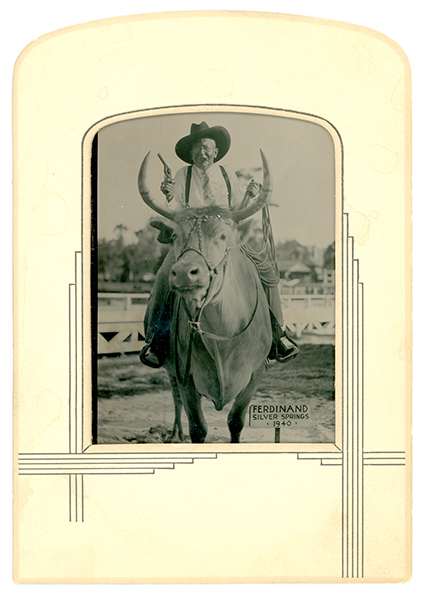
Ferdinand the Bull

Ferdinand the Bull
As a collector I never know where my next find will lead me. My first impression of this image was that it's a shot of a rodeo entertainer. I liked the way it looks, so I bought the photo from the antiques dealer without giving it much more thought. The shopping day was nearly over. I left with my purchase and rushed on to the next store.
Studying the photograph more closely at home, I re-read the sign in the lower right. It says: "Ferdinand" "Silver Springs" "1940". Then it came to me, Ferdinand was the name of the bull. Silver Springs could be one of many towns with that name in the United States. And 1940 — that was obvious. I started to remember something about a story I'd read as a kid about a bull named Ferdinand.
With a little research, I started to piece together what this well-dressed gentleman brandishing a six-shooter was doing atop a bull named Ferdinand.
In 1935, author and illustrator Munro Leaf wrote The Story of Ferdinand, an entertaining short story for children. The story was published in book form in 1936 with illustrations by Leaf's friend Robert Lawson. Ferdinand was a mellow bull, content to smell flowers, not the type to get in fights with matadors. But then one day ... well, read the story yourself. Or to your children. They'll enjoy it. And that's the point. Children did enjoy this story. Ferdinand's popularity lead Walt Disney to create an Academy Award winning animated short film, Ferdinand the Bull. The Disney short, released in 1938, was very popular with young children.
Perhaps Ferdinand the Bulls began cropping up at county fairs, rodeos and carnivals around the country. Itinerant photographers may have taken photographs of fans and performers sitting on Ferdinand.
The photograph was taken on direct-positive paper and is mounted in a decorated paper frame. Direct-positive photographs were mainly made on paper, iron (tintype), glass (ambrotype) and silver plated copper (daguerreotype). The tintype and paper positive processes could produce a finished picture in a few minutes, so they were well suited to the needs of street photographers.
This photograph, measuring 3 x 4 1/2 inches is mounted in a 4 1/2 x 6 1/2 inch paper frame.
If you have an interest in the cameras used by itinerant photographers, two street cameras are featured on this site. These are a Chicago Ferrotype Company Mandelette Postcard Camera and an Itinerant Photographer's Candid Camera.

|
Page created October 22, 2002;
updated December 20, 2020 |